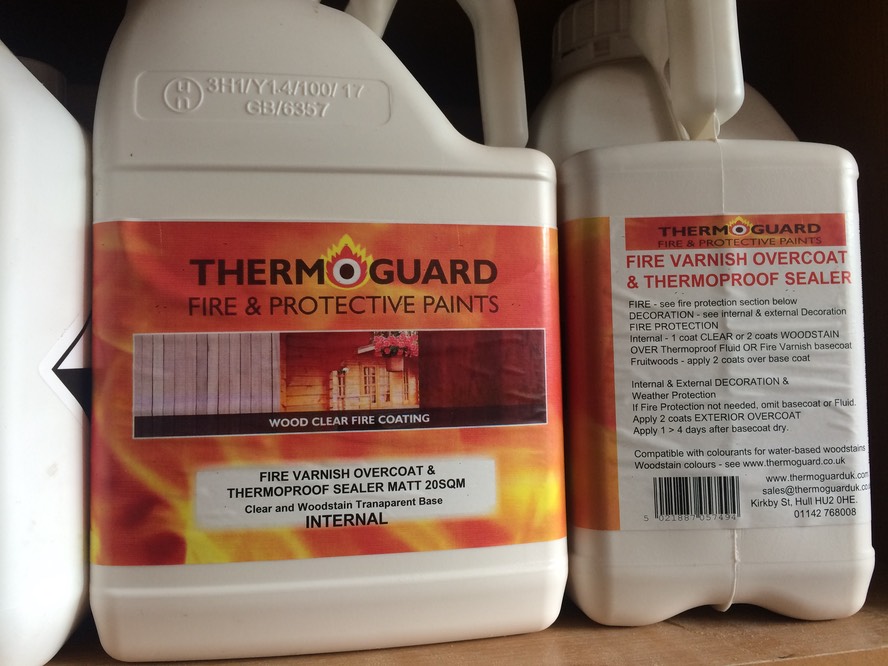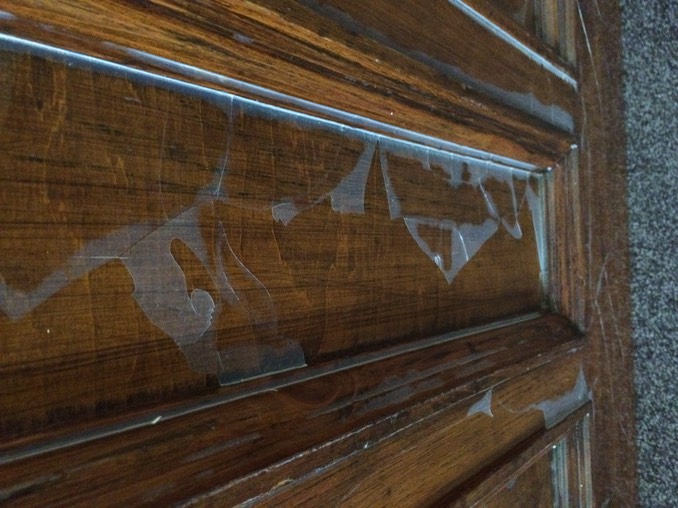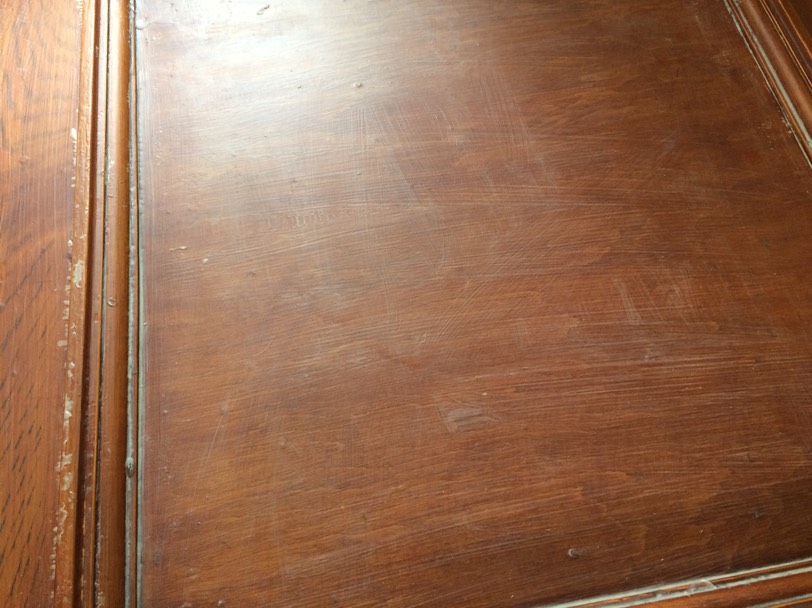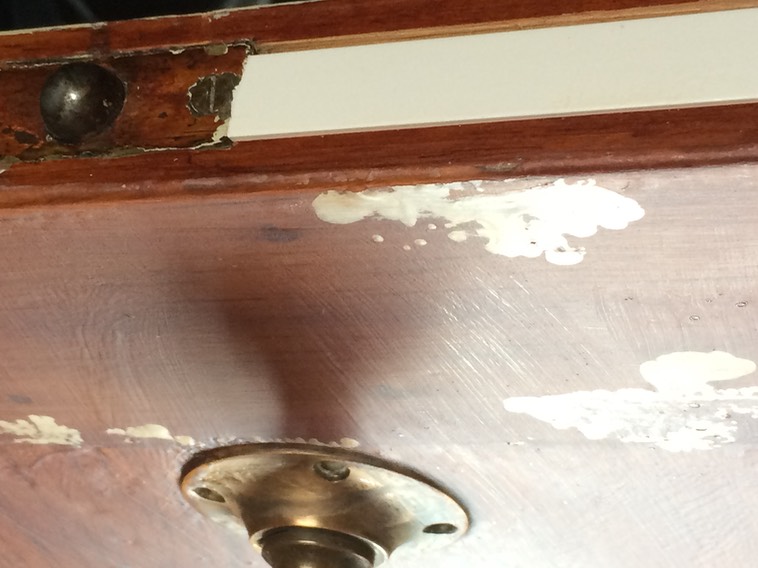
I have had a serious problem fighting with a horrible binary paint, in tins far too big for the work I am prepared to do in a day, and other issues like fumes. I have moved the associated maths to Y8 extension work. This is the story of trying to use, but mostly of failing to work with, this paint.
The paint comes in A and B and is to be mixed on the day of use. The tin containing A is where B is to be put—though that is far from obvious—and the instructions say 1:1 where what that means is one of B goes into one of A; the plastic bottle of B is poured (very) carefully into tin A. The stuff in B has a high content of phosphoric acid, quite scary; A and B mixed puts out fumes that make one wish to do the painting outside; the paint takes an age to dry and then needs a sealing coat of varnish applied within 3-7 days or the base layer comes off. All this comes from the instructions, but these are not all written on the tin. And the writing assumes a lot of implied knowledge; which strikes me as wrong in a very recursive way.
Not least of the problems I had is that reference "1:1": the other occasions I have come across such a reference would all have indicated 1:12 by volume or by mass (or something else, but it would be indicated. This says as quoted with no additional hints. Discovering that B is to go into A is fairly well hidden. All of this suggests to me that the instructions are being treated as useless and that by implication and inference this paint is only used by those in the know, having seen it used in some earlier experience. A further implication is that this is not a product the company wishes to be widely used.
The paint is a fire-retardant; it raises the fire resistance of an existing door significantly and as such allows me to keep the original doors in the house rather than have to replace the (very nice) wooden doors with relatively uninteresting modern ones. The paint is very expensive; I could 'send the doors away' to be painted at around £200-£300 per door and have a week or two without doors. Sufficient paint for ten doors is the same as the cost of sending two doors away to be coated. Additionally, each door has to have an intumescent strip inserted in a groove around three sides (not the bottom). This will seal the door into the frame in a fire, which reduces spread of fire so that residents might have longer to escape. Quite why I am required to do this in my own home I do not understand, but if the regulations are applicable (that's the dispute), they are there to be followed. The required groove for the intumescent strip is made with a tool called a router (rowter, not rooter) and I can do that myself at about two hours per door. The elapsed time quite a bit longer, since both the tool and the user need to cool down; I need coffee at frequent intervals too. And it makes a mess, not at all compatible with the painting process.
I mixed A and B as per the instructions and discovered (only) some of the problems: the lengthy difficulty with the fumes; the drying time; that the doors really needed to be out of the frames and level; that the brushes would have to be written off afterwards. The experience was so bad, I have left the doors alone for months and the base coat has delaminated—come unstuck from the door—with what looks like air underneath the finish. Clearly the doors have to be done all over again. Based on the previous experience I think it would be sensible to do a door or at most two doors at a time, and to keep the doors off the hinges while they are worked on.


Mixing a full tin of A&B combined painted all ten doors adequately on one side each. But the paint dripped horribly and it sets into a rigid skin like a stiff plastic, reasonably clear, quite a gloss finish. Apart from the drips, it looks quite good. The doors I took off the hinges look good. Well, looked good through the winter, but as the world warned up in late March, delamination set in. I think I might target doing a door a day, either routing or painting. After a very long time running scared at the prospect of doing all this work again—and the fumes were sufficiently awful I could see the deterioration in daily running time—I decided that the way forwards was to do a single door to see if that made the whole thing a doable task. Since the paints have to be mixed on the day, I spent quite some time delaying while I wondered how to measure the right amounts into a suitable container. That is, I need a tenth of what is in tin A and to mix it with a tenth of what is in container B. These are not equal amounts, and some of the experiments show that the mixture has to be right, right enough to fit between being unworkably stiff or unworkably liquid.


Eventually I found I could use paint sample pots, each of which was just right for the amount of A for one door, and I marked up a jam-jar so that A went in and then I filled with B to an appropriate mark. Significantly, the nasty B is added to A, not A added to B. That is, whatever is used for painting from (dipping the brush into) starts with A at the correct amount. I learned how to clean the brush so I can re-use it. I learned that residual cleaner on the brush prevents the paint from sticking. I learned that some parts of the surface are highly resistant to having paint put on them (and not then delaminating overnight) and as yet I have not found what this is caused by, nor how to clean the surface so it attaches smoothly and reliably so..
There's no way the wife will accept having doors (doors she uses) missing when she's at home, especially home for a run of days, so I can't (mustn't) come up with models that cause marital conflict; it's bad enough just doing this painting without adding stresses. I'm pretty sure I can't take one door and expect it to fit the hinges or doorframe of another door. Perhaps one carefully chosen door will fit one other frame, but I do not expect any targeted door to have an alternative in the house. As we have moved into coronavirus lockdown, so I am reduced to making the two doors I have taken off become the experiment, to find what will and will not work. Two weeks into lockdown I have cleaned bits of door several times back to the bare wood, so bad is this paint to work with.
To stop the paint delaminating over time, there is a varnish top coat, sadly matt not gloss. This goes on to the nice gloss surface and looks like over-age yoghurt. This looks so awful that the first time I did this I took the top coat off again before it dried. I ran an experiment on a scrap piece of board, to discover that this top coat clears as it dries. But it doesn't do that regularly or reliably. Pictures show this. My test piece formed a sort of skin on top of the fire paint coat, possibly doing some chemistry, but this skin then split in a few places as it dried, so the finish is eventually uneven. The splits are few but lengthy, and more coats only preserve the split in the depth of varnish. Applying the paint to a horizontal door puts one's face above the work; I discover that there must be chemistry occurring, because fumes are detectable that don't belong with either the door or the top coat varnish, only the combination. I learn to brush from the side, head clear of paintwork and fumes. Painting just one door is not malodorous; clearly painting ten was another error, but then that means mixing the paint as directed was an error. Go figure; does that mean this should be done at scale in a very large space, or outside, where all sorts of things can come add themselves to the sticky surface?
This is awful. The result is not acceptable. I have not found any combination of methods that will reliably (that is an important component) produce an acceptable result. Sadly, as these experiments have proceeded, so the unvarnished fire paint on doors elsewhere in the house have begun to delaminate as March has warmed up into April. As yet, I have none (really, none) of the panels at any acceptable finish, let alone a door in a state I will accept as 'done'.
A rethink is in order.
DJS 20200404
Today, sufficient cough to consider a day off running, making for longer at a desk, still running away from this horrid paint.
Top pic is of the varnish paint pots, not the binary paint.
Addendum, 20210322
I repainted doors, varnished them and rehung them. The combined paints have all delaminated over the summer. The door with the best finish has many layers of the fireproof undercoat, amounting to a significant thickness exceeding a millimetre. Even this has unsightly lacunae in its surface and I have at best a whole square foot of acceptable finish across the ten doors. March 2021 has been spent removing the finish and returning the doors to their previous state. I can just about do a door a day but the result is very much better if I take twice as long; one day chipping away at the previous work in diminishing bursts of enthusiasm, probably totalling seven hours and showing that in each return I can find some patches i have missed. Some of the finish is very stubborn to remove and some is trivially easy, so that achieving an acceptably even raw state of 'undressed' is difficult. Overnight I then put some Danish oil on the raw bits, often cleaning with white spirit first. The second day is spent allowing subsequent coats to dry, with some polishing in between and then extensive polishing later, along with returning the door to its vertical position and more polishing, thought sometimes I've done the rehanging on day three. The result is so very much better than the fire paint produced, even where there are places where I'd like to try again for an even better finish. I can take particularly difficult doors (the office doors, the kitchen door) down on a Tuesday morning and have them back on Wednesday afternoon, fitting with the wife's duty night (when we won't be using her office or the kitchen. Today, right now, is a Tuesday and I have the kitchen door off, cleaned and with its first dabs of oil on the raw bits where the old finish is completely gone.
On the way through this process i have learned just how very heavy some of these doors are and, given that the original requirement was that they be 'half-hour fire doors' with a clear statement that twenty minutes would suffice, I reckon that they always were at that standard. We have new fire doors at the ends of the staircase—think basement and attic—both of which are officially rated (that is, I bought them on the understanding that they meet the fire criterion). This is not a house of multiple occupation and I think the doors that matter most are the two extremes and the kitchen. The kitchen door is quite easily the heaviest door I have done and is number six of the nine I'm going to work on. Wire wool works well after the scraping and works very well indeed on our brass door furniture.
Partial answers: I think the volume of A from 1.07 to 1.135 ml. I used radius of 72.5, 73 and 74 and a depth of paint as 65 and 66mm.